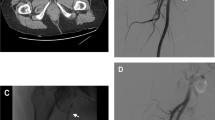Abstract
Lower extremity pseudoaneurysms (PsAs) are mostly developed after traumatic or iatrogenic injury to the arteries. Unless treated, they can be complicated by adjacent mass effects, distal embolism, secondary infection, and rupture. Imaging helps in the diagnosis and planning of therapeutic intervention. Ultrasonography (USG) is often diagnostic, while CT angiography aids in vascular mapping required for intervention. Image-guided therapy offers to manage these pseudoaneurysms in a minimally invasive approach, obviating the need for surgery. A smaller, superficial, and narrow-necked PsA can easily be managed with local USG-guided compression or thrombin injection. When the percutaneous approach is not a feasible option, PsA from expendable arteries can also be managed with coiling or glue injection. Wide-necked PsA from an unexpendable artery necessitates stent graft placement, although coiling of the neck may be a viable and cheaper alternative for a long- and narrow-necked PsA. Presently, vascular closure devices are also used to seal a small arterial rent through a direct percutaneous approach. This pictorial review entails various techniques to deal with lower extremity pseudoaneurysms. An idea about the various intervention radiological approaches will help in choosing appropriate methods to tackle lower extremity pseudoaneurysms.







Similar content being viewed by others
Change history
26 June 2023
A Correction to this paper has been published: https://doi.org/10.1007/s10140-023-02155-4
References
Henry JC, Franz RW (2019) Pseudoaneurysms of the peripheral arteries. Int J Angiol 28(1):20–24. https://doi.org/10.1055/s-0039-1677676
Raherinantenaina F, Rakoto-Ratsimba HN, Rajaonanahary TM (2016) Management of extremity arterial pseudoaneurysms associated with osteochondromas. Vascular 24(6):628–637. https://doi.org/10.1177/1708538116634532
Morgan R, Belli AM (2003) Current treatment methods for postcatheterization pseudoaneurysms. J Vasc Interv Radiol 14(6):697–710. https://doi.org/10.1097/01.rvi.0000071089.76348.6a
Katzenschlager R, Ugurluoglu A, Ahmadi A, Hülsmann M, Koppensteiner R, Larch E, Maca T, Minar E, Stümpflen A, Ehringer H (1995) Incidence of pseudoaneurysm after diagnostic and therapeutic angiography. Radiology 195(2):463–466. https://doi.org/10.1148/radiology.195.2.7724767
Madia C (2019) Management trends for postcatheterization femoral artery pseudoaneurysms. JAAPA 32(6):15–18. https://doi.org/10.1097/01.JAA.0000558236.60240.02
Stone PA, Campbell JE, AbuRahma AF (2014) Femoral pseudoaneurysms after percutaneous access. J Vasc Surg 60(5):1359–1366. https://doi.org/10.1016/j.jvs.2014.07.035
Kresowik TF, Khoury MD, Miller BV, Winniford MD, Shamma AR, Sharp WJ, Blecha MB, Corson JD (1991) A prospective study of the incidence and natural history of femoral vascular complications after percutaneous transluminal coronary angioplasty. J Vasc Surg 13(2):328–33; discussion 333–5
Huseyin S, Yuksel V, Sivri N, Gur O, Gurkan S, Canbaz S, Ege T, Sunar H (2013) Surgical management of iatrogenic femoral artery pseudoaneurysms: a 10-year experience. Hippokratia 17(4):332–336
Sarioglu O, Capar AE, Belet U (2019) Interventional treatment options in pseudoaneurysms: different techniques in different localizations. Pol J Radiol 23(84):e319–e327. https://doi.org/10.5114/pjr.2019.88021
Saad NE, Saad WE, Davies MG, Waldman DL, Fultz PJ, Rubens DJ (2005) Pseudoaneurysms and the role of minimally invasive techniques in their management. Radiographics 25(Suppl 1):S173–S189. https://doi.org/10.1148/rg.25si055503
Gorsi U, Agarwal V, Yaser M, Kalra N, Chaluvashetty S, Kang M, Lal A, Sandhu MS (2021) Utility of percutaneous thrombin injection for treating visceral pseudoaneurysms. Minim Invasive Ther Allied Technol 30(3):174–178. https://doi.org/10.1080/13645706.2020.1720251
Vowels TJ, Zubair MM, Bismuth J, Le L (2020) Balloon-assisted ultrasound-guided percutaneous thrombin injection of iatrogenic femoral artery pseudoaneurysms: a case report and description of the technique. Vasc Endovascular Surg 54(6):532–535. https://doi.org/10.1177/1538574420927861
Bansal A, Gorsi U, Farook S, Savlania A, Sandhu MS (2021) Interventional radiology management of extremity pseudoaneurysms: a pictorial essay. Emerg Radiol 28(5):1029–1039. https://doi.org/10.1007/s10140-021-01939-w
Madhusudhan KS, Venkatesh HA, Gamanagatti S, Garg P, Srivastava DN (2016) Interventional radiology in the management of visceral artery pseudoaneurysms: a review of techniques and embolic materials. Korean J Radiol 17(3):351–63. https://doi.org/10.3348/kjr.2016.17.3.351
Loh EJ, Allen R (2019) Endovascular treatment of refractory iatrogenic femoral artery pseudoaneurysm using Amplatzer vascular plugs following unsuccessful retrograde Angio-Seal deployment. Indian J Radiol Imaging 29(2):211–214. https://doi.org/10.4103/ijri.IJRI_332_18
Marks JA, Hager E, Henry D, Martin ND (2011) Lower extremity vascular stenting for a post-traumatic pseudoaneurysm in a young trauma patient. J Emerg Trauma Shock 4(2):302–305. https://doi.org/10.4103/0974-2700.82230
Robken J, Shammas NW (2016) Novel technique to treat common femoral artery pseudoaneurysm using Angio-Seal closure device. Int J Angiol 25(4):266–270. https://doi.org/10.1055/s-0034-1382100
Kodama T, Yamaguchi T, Fujiwara H, Kuwabara M (2022) Successful endovascular repair of complicated pseudoaneurysm using Perclose ProGlide: a novel concept. Clin Case Rep 10(11):e6655. https://doi.org/10.1002/ccr3.6655
Author information
Authors and Affiliations
Corresponding author
Ethics declarations
Informed consent
Informed consent was obtained from the patients for the images shown in the present pictorial essay.
Conflict of interest
The authors declare that they have no conflict of interest.
Additional information
Publisher's note
Springer Nature remains neutral with regard to jurisdictional claims in published maps and institutional affiliations.
The original online version of this article was revised: The original article contains an error in author name. Alamellu Alagapan should be updated to Alamelu Alagappan.
Rights and permissions
Springer Nature or its licensor (e.g. a society or other partner) holds exclusive rights to this article under a publishing agreement with the author(s) or other rightsholder(s); author self-archiving of the accepted manuscript version of this article is solely governed by the terms of such publishing agreement and applicable law.
About this article
Cite this article
Patel, R.K., Alagappan, A., Tripathy, T. et al. Lower extremity pseudoaneurysms and their interventional radiological management: a pictorial review. Emerg Radiol 30, 555–561 (2023). https://doi.org/10.1007/s10140-023-02151-8
Received:
Accepted:
Published:
Issue Date:
DOI: https://doi.org/10.1007/s10140-023-02151-8




